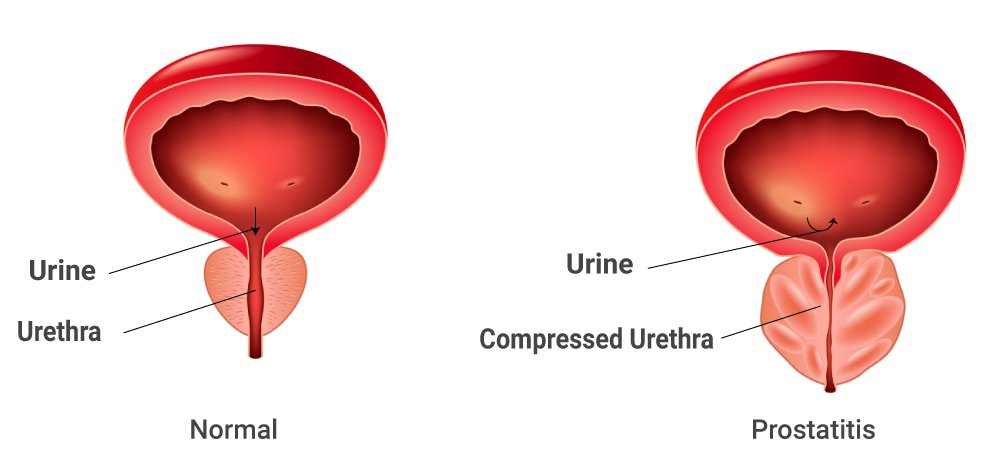What is Prostatitis?
Prostatitis is the inflammation of the prostate gland, a small organ positioned below the bladder and in front of the rectum. The urethra, responsible for carrying urine and semen out of the body, passes through the center of the prostate.

The condition manifests in four types, causing the tissue around the prostate to become swollen, tender, and irritated. Certain types may be triggered by urinary tract infections (UTIs) or bacterial infections, while others have no identifiable cause. Treatments are available to manage symptoms.
Prostatitis is characterized by painful or difficult urination and discomfort in the groin, pelvic area, or genitals. Bacterial infections contribute to some cases, but not all. The prostate, roughly the size of a walnut, surrounds the upper part of the urethra and produces fluid crucial for transporting sperm during ejaculation (semen).
Types of Prostatitis
Prostatitis can be classified into several types:
- Acute Bacterial Prostatitis: Caused by a bacterial infection, this form of prostatitis can be sudden and severe. Symptoms my include fever, chills, pain in the lower abdomen or lower back, and discomfort during urination.
- Chronic Bacterial Prostatitis: Characterized by recurrent urinary tract infections linked to bacteria in the prostate. Symptoms may be less severe but persist over a longer period.
- Chronic Prostatitis/Chronic Pelvic Pain Syndrome (CP/CPPS): This is the most common type and presents with long-term pelvic pain and discomfort. The cause is often unknown, and symptoms may include pain during urination, difficulty urinating, and discomfort in the genital and pelvic area.
- Asymptomatic Inflammatory Prostatitis: In this type, there is inflammation in the prostate, but there are no noticeable symptoms. It is often discovered incidentally during medical examinations for other conditions.

Symptoms of Prostatitis
Prostatitis symptoms can vary depending on the type of prostatitis a person has. Here are common symptoms associated with different types:
- Acute Bacterial Prostatitis:
- Sudden onset of symptoms.
- High fever and chills.
- Pain or burning sensation during urination.
- Frequent urge to urinate.
- Lower abdominal or pelvic pain.
- discomfort or Pain in the testicles or penis.
- Chronic Bacterial Prostatitis:
- Recurrent urinary tract infections.
- Frequent or urgent need to urinate.
- Pain or discomfort in the pelvic area.
- Pain or burning during urination.
- Discomfort or pain in the penis or testicles.
- Chronic Prostatitis/Chronic Pelvic Pain Syndrome (CP/CPPS):
- Persistent pelvic pain or discomfort (often lasting for at least three months).
- Pain in the genitals or rectal area.
- Pain or discomfort during or after ejaculation.
- Lower back pain.
- Frequent or urgent need to urinate.
- Pain or burning during urination.
- Asymptomatic Inflammatory Prostatitis:
- Typically no noticeable symptoms.
- Inflammation is detected incidentally during medical examinations.
It’s important to note that the symptoms of prostatitis can overlap, and some individuals may experience a combination of symptoms.
Causes of Prostatitis
- Bacterial Infection:
- Acute Bacterial Prostatitis: Caused by a bacterial infection, often originating from the urinary tract or other parts of the body. Bacteria can enter the prostate, leading to inflammation.
- Chronic Bacterial Prostatitis: Recurrent urinary tract infections can be a source of chronic bacterial prostatitis. Bacteria may be present in the prostate, causing persistent inflammation.
- Non-Bacterial Causes:
- Chronic Prostatitis/Chronic Pelvic Pain Syndrome (CP/CPPS): The exact cause is often unknown, and it may not be related to bacterial infection. Inflammation and pain may result from non-bacterial factors, such as autoimmune reactions or nerve issues.
- Asymptomatic Inflammatory Prostatitis:
- The cause is often unclear, and individuals may not experience noticeable symptoms. Inflammation is detected incidentally during medical examinations.
- Pelvic Trauma:
- Injury or trauma to the pelvic region may contribute to the development of prostatitis.
- Urethral Infection:
- In some cases, infection of the urethra can spread to the prostate, causing prostatitis.
prostatitis is a complex condition, and the specific cause may not always be identified. Additionally, the classification of prostatitis into acute or chronic forms, and whether it is bacterial or non-bacterial, influences the approach to diagnosis and treatment.
Prostatitis Treatment at Home
While professional medical advice is essential for treating prostatitis, there are some self-care measures that individuals can consider at home to complement medical treatment and alleviate symptoms
- Drink plenty of water to help flush out bacteria and maintain overall urinary tract health.
- Soaking in a warm bath may help relax pelvic muscles and alleviate pain or discomfort.
- Limit or avoid substances that can irritate the prostate, such as caffeine, spicy foods, and alcohol.
- Performing pelvic floor exercises, such as Kegel exercises, may help strengthen and relax the pelvic muscles.
- Practice stress-reduction techniques, such as deep breathing, meditation, or yoga, as stress can exacerbate symptoms.
- Ensure proper hygiene to prevent infections. Clean the genital area thoroughly, and practice safe sex.
Conclusion
Prostatitis, an inflammatory condition impacting men’s urinary and reproductive health, finds expert attention from Dr. Saket Narnoli in urology. His diagnostic and management skills address the diverse spectrum of prostatitis, requiring tailored treatments. His holistic approach integrates antibiotics, anti-inflammatory drugs, and lifestyle adjustments. Patient education is central, empowering active participation in health. Timely consultation to Dr. Saket Narnoli’s prescribed treatments promise optimal outcomes for those grappling with prostatitis.






